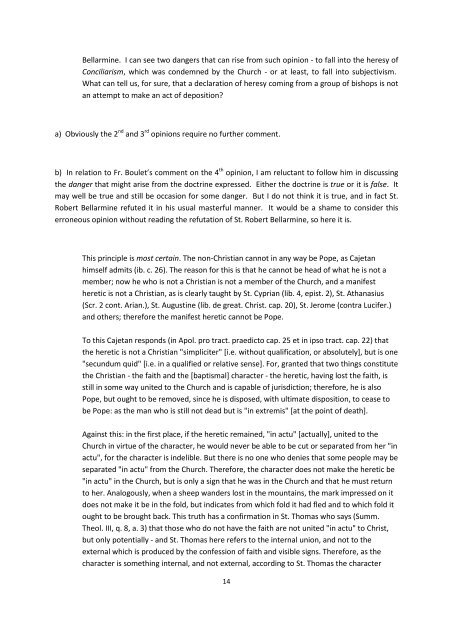Concerning an SSPX Dossier on Sedevacantism - Novus Ordo Watch
Concerning an SSPX Dossier on Sedevacantism - Novus Ordo Watch
Concerning an SSPX Dossier on Sedevacantism - Novus Ordo Watch
You also want an ePaper? Increase the reach of your titles
YUMPU automatically turns print PDFs into web optimized ePapers that Google loves.
Bellarmine. I c<str<strong>on</strong>g>an</str<strong>on</strong>g> see two d<str<strong>on</strong>g>an</str<strong>on</strong>g>gers that c<str<strong>on</strong>g>an</str<strong>on</strong>g> rise from such opini<strong>on</strong> - to fall into the heresy of<br />
C<strong>on</strong>ciliarism, which was c<strong>on</strong>demned by the Church - or at least, to fall into subjectivism.<br />
What c<str<strong>on</strong>g>an</str<strong>on</strong>g> tell us, for sure, that a declarati<strong>on</strong> of heresy coming from a group of bishops is not<br />
<str<strong>on</strong>g>an</str<strong>on</strong>g> attempt to make <str<strong>on</strong>g>an</str<strong>on</strong>g> act of depositi<strong>on</strong>?<br />
a) Obviously the 2 nd <str<strong>on</strong>g>an</str<strong>on</strong>g>d 3 rd opini<strong>on</strong>s require no further comment.<br />
b) In relati<strong>on</strong> to Fr. Boulet’s comment <strong>on</strong> the 4 th opini<strong>on</strong>, I am reluct<str<strong>on</strong>g>an</str<strong>on</strong>g>t to follow him in discussing<br />
the d<str<strong>on</strong>g>an</str<strong>on</strong>g>ger that might arise from the doctrine expressed. Either the doctrine is true or it is false. It<br />
may well be true <str<strong>on</strong>g>an</str<strong>on</strong>g>d still be occasi<strong>on</strong> for some d<str<strong>on</strong>g>an</str<strong>on</strong>g>ger. But I do not think it is true, <str<strong>on</strong>g>an</str<strong>on</strong>g>d in fact St.<br />
Robert Bellarmine refuted it in his usual masterful m<str<strong>on</strong>g>an</str<strong>on</strong>g>ner. It would be a shame to c<strong>on</strong>sider this<br />
err<strong>on</strong>eous opini<strong>on</strong> without reading the refutati<strong>on</strong> of St. Robert Bellarmine, so here it is.<br />
This principle is most certain. The n<strong>on</strong>-Christi<str<strong>on</strong>g>an</str<strong>on</strong>g> c<str<strong>on</strong>g>an</str<strong>on</strong>g>not in <str<strong>on</strong>g>an</str<strong>on</strong>g>y way be Pope, as Cajet<str<strong>on</strong>g>an</str<strong>on</strong>g><br />
himself admits (ib. c. 26). The reas<strong>on</strong> for this is that he c<str<strong>on</strong>g>an</str<strong>on</strong>g>not be head of what he is not a<br />
member; now he who is not a Christi<str<strong>on</strong>g>an</str<strong>on</strong>g> is not a member of the Church, <str<strong>on</strong>g>an</str<strong>on</strong>g>d a m<str<strong>on</strong>g>an</str<strong>on</strong>g>ifest<br />
heretic is not a Christi<str<strong>on</strong>g>an</str<strong>on</strong>g>, as is clearly taught by St. Cypri<str<strong>on</strong>g>an</str<strong>on</strong>g> (lib. 4, epist. 2), St. Ath<str<strong>on</strong>g>an</str<strong>on</strong>g>asius<br />
(Scr. 2 c<strong>on</strong>t. Ari<str<strong>on</strong>g>an</str<strong>on</strong>g>.), St. Augustine (lib. de great. Christ. cap. 20), St. Jerome (c<strong>on</strong>tra Lucifer.)<br />
<str<strong>on</strong>g>an</str<strong>on</strong>g>d others; therefore the m<str<strong>on</strong>g>an</str<strong>on</strong>g>ifest heretic c<str<strong>on</strong>g>an</str<strong>on</strong>g>not be Pope.<br />
To this Cajet<str<strong>on</strong>g>an</str<strong>on</strong>g> resp<strong>on</strong>ds (in Apol. pro tract. praedicto cap. 25 et in ipso tract. cap. 22) that<br />
the heretic is not a Christi<str<strong>on</strong>g>an</str<strong>on</strong>g> "simpliciter" [i.e. without qualificati<strong>on</strong>, or absolutely], but is <strong>on</strong>e<br />
"secundum quid" [i.e. in a qualified or relative sense]. For, gr<str<strong>on</strong>g>an</str<strong>on</strong>g>ted that two things c<strong>on</strong>stitute<br />
the Christi<str<strong>on</strong>g>an</str<strong>on</strong>g> - the faith <str<strong>on</strong>g>an</str<strong>on</strong>g>d the [baptismal] character - the heretic, having lost the faith, is<br />
still in some way united to the Church <str<strong>on</strong>g>an</str<strong>on</strong>g>d is capable of jurisdicti<strong>on</strong>; therefore, he is also<br />
Pope, but ought to be removed, since he is disposed, with ultimate dispositi<strong>on</strong>, to cease to<br />
be Pope: as the m<str<strong>on</strong>g>an</str<strong>on</strong>g> who is still not dead but is "in extremis" [at the point of death].<br />
Against this: in the first place, if the heretic remained, "in actu" [actually], united to the<br />
Church in virtue of the character, he would never be able to be cut or separated from her "in<br />
actu", for the character is indelible. But there is no <strong>on</strong>e who denies that some people may be<br />
separated "in actu" from the Church. Therefore, the character does not make the heretic be<br />
"in actu" in the Church, but is <strong>on</strong>ly a sign that he was in the Church <str<strong>on</strong>g>an</str<strong>on</strong>g>d that he must return<br />
to her. Analogously, when a sheep w<str<strong>on</strong>g>an</str<strong>on</strong>g>ders lost in the mountains, the mark impressed <strong>on</strong> it<br />
does not make it be in the fold, but indicates from which fold it had fled <str<strong>on</strong>g>an</str<strong>on</strong>g>d to which fold it<br />
ought to be brought back. This truth has a c<strong>on</strong>firmati<strong>on</strong> in St. Thomas who says (Summ.<br />
Theol. III, q. 8, a. 3) that those who do not have the faith are not united "in actu" to Christ,<br />
but <strong>on</strong>ly potentially - <str<strong>on</strong>g>an</str<strong>on</strong>g>d St. Thomas here refers to the internal uni<strong>on</strong>, <str<strong>on</strong>g>an</str<strong>on</strong>g>d not to the<br />
external which is produced by the c<strong>on</strong>fessi<strong>on</strong> of faith <str<strong>on</strong>g>an</str<strong>on</strong>g>d visible signs. Therefore, as the<br />
character is something internal, <str<strong>on</strong>g>an</str<strong>on</strong>g>d not external, according to St. Thomas the character<br />
14


